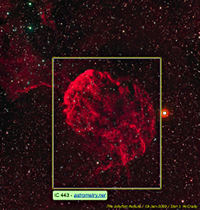A robot intelligence has invaded Flickr. The “blind astrometry server” is a program which monitors the Astrometry group on Flickr, looking for new photos of the night sky. It then analyzes each photo, and from the unique star positions shown it figures out what part of the sky was photographed and what interesting planets, galaxies or nebulae are contained within. Not only does the photographer get a high-quality description of what’s in their photo, but the main Astrometry.net project gets a new image to add to its storehouse of knowledge.
Needless to say this is one of the coolest uses of Flickr groups and the API that we’ve ever seen. I recently discussed the project with team member Christopher Stumm, since he was the one who had the idea to hook it into Flickr.
With Astrometry.net, you’re distributing the work of cataloguing the sky to amateurs. Are we still in an age where the average person can make contributions to astronomical science?
Definitely. There’s a large number of excellent amateur setups out there, and they discover supernovae and minor planets regularly. Although science-grade data is generated, it can be difficult to use because it’s hard to find, and there’s typically no useful meta-data. We’re hoping to help with that problem.
The catalog we use to solve images was put together from surveys during the last 50 years – that’s a long time! We believe that if the information generated by the amateur astronomer community is harnessed we could build an open-source sky survey much faster.
On top of that, we would be able see what areas of the sky have interesting activity. Right now we’re using images from around the web to calculate the path comet Holmes took through the sky.
Your scale and rotation invariant hashing algorithm is fiendishly clever. Where does it come from?
It’s an adaptation of an old idea in computer vision — “geometric hashing” — to astronomical images. It was originally created by researchers who were trying to model associative memory; “that shape reminds me of something I’ve seen before”. The idea works great for astronomical pictures, because stars are easy to locate exactly. By adding a fast search method for similar-shaped arrangements of stars, and a check that eliminates coincidental matches, we’re able to match an image against the whole sky, usually in a matter of seconds.
Actually, sometimes we still do get false matches, but it turns out that that’s almost always because of some problem in either the image or our reference. These are places where we could use many amateur astronomer images to patch our reference catalog.
Have there been any surprises about the data you’ve received, or the response you’ve gotten? Any discoveries?
One thing that has surprised me has been the amount of positive feedback we’ve gotten. The project was covered on a few sites including kottke.org, Reddit, and O’Reilly’s Make magazine. After reading about it people had to test it out, so we saw pictures from people’s back yards, some people tried to fool the system by inputting hand-drawn images, and one person even passed in a screen shot from an iPhone application which shows you the night sky.
The submissions range from amazingly high quality to images where someone just took their camera and pointed it at the night sky with some trees and a house included too. I was surprised how robust our solver was to some of the obstructions we find in the images.
Overall I think it shows people are curious about the sky, but it can be pretty very overwhelming due to its sheer size. Hopefully we help make it a little more approachable by showing people what’s in their picture.
Why Flickr? How has the experience been?
I was a Flickr user, liked the service, and believed it offered much of what we were looking for at the time. Flickr had a huge user base which meant it was familiar and would be easy for users to upload images, submit them to our group, and offered basically unlimited scalability.
The image annotations offered by Flickr were really the icing on the cake and made the whole feature much more compelling, especially to people who aren’t astronomy buffs such as myself. On top of that the API made it easy to hook into. I can’t really complain about anything so far with the whole experience, it’s been a lot of fun.

